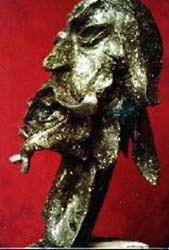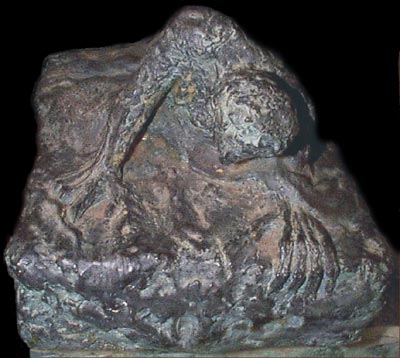Belzec
All information below comes from
Belzec, Sobibor, Treblinka: the
Operation Reinhard Death Camps,
by Yitzhak Arad, published by Indiana
University Press, 1987,
Copyright © 1987 by Yitzhak Arad
Reproduced with permission of the publisher,
Indiana University Press, Bloomington,
Indiana.
 Belzec was the first camp
devoted exclusively to extermination and therefore the model
for all subsequent such camps. The gassings conducted
there were intended as experiments that would establish
which methods might be most efficient for killing large
numbers of human beings. As Zyklon B had not yet been
developed, the gas used at Belzec was carbon monoxide engine
exhaust. The Nazis attempted, however, to keep the
Jews (who were arriving in packed boxcars) unaware of their
fate until the moment it overtook them. Deceit was the
order of the day, with an elaborate masquerade devised to
fool the victims. Arad offers the following testimony
by SS Scharfuhrer Erich Fuchs, from the trial of SS
Oberscharfuhrer Josef Oberhauser, the officer who was
in charge of the construction of Belzec:
Belzec was the first camp
devoted exclusively to extermination and therefore the model
for all subsequent such camps. The gassings conducted
there were intended as experiments that would establish
which methods might be most efficient for killing large
numbers of human beings. As Zyklon B had not yet been
developed, the gas used at Belzec was carbon monoxide engine
exhaust. The Nazis attempted, however, to keep the
Jews (who were arriving in packed boxcars) unaware of their
fate until the moment it overtook them. Deceit was the
order of the day, with an elaborate masquerade devised to
fool the victims. Arad offers the following testimony
by SS Scharfuhrer Erich Fuchs, from the trial of SS
Oberscharfuhrer Josef Oberhauser, the officer who was
in charge of the construction of Belzec:
.
. . barracks were built as gas chambers. I installed shower
heads in
the
gas chambers. The nozzles were not connected to any water
pipes; they
would
serve as camouflage for the gas chamber. For the Jews who
were
gassed
it would seem as if they were being taken to baths and for disinfection.
page
24
The
first commander of the Belzec camp was, ironically, a man named
"Christian Wirth," a veteran of Hitler's euthanasia
program. Wirth served from December, 1941, until August
1942, when he was appointed Inspector of all three death camps
and replaced as commander of Belzec by SS Hauptsturmfuhrer
Gottlieb Hering. Kurt Franz, an officer under Wirth, later
testified:
I
heard with my own ears how Wirth, in a quite convincing voice,
explained
to the Jews that they would be deported further and before
that,
for hygienic reasons, they must bathe themselves and their
clothes
would have to be disinfected. Inside the undressing
barrack
was
a counter for the deposit of valuables. It was made clear
to the
Jews
that after the bath their valuables would be returned to
them. I
can
still hear, until today, how the Jews applauded Wirth after his
speech.
This behavior of the Jews convinces me that the Jews believed
Wirth
. . .
page 70
The
following account of a gassing at Belzec is from Obersturmfuhrer
Kurt Gerstein, who visited the camps to advise on how to
disinfect the clothes of murdered Jews.
. . . the march began. To the left and right, barbed
wire; behind;
two
dozen Ukrainians, guns in hand.
They
approached. Wirth and I were standing on the ramp in
front
of the death chambers. Completely nude men, women, young
girls,
children, babies, cripples, filed by. At the corner stood
a heavy
SS
man, who told the poor people, in a pastoral voice: 'No
harm will
come
to you. You just have to breathe very deeply, that
strengthens
the
lungs, inhaling is a means of preventing contagious diseases.
It's
a
good disinfection!' They asked what was going to happen to
them.
He
told them: 'The men will have to work, building roads and
houses.
But
the women won't be obliged to do so; they'll do housework,
cooking.'
For some of these poor creatures, this was a last small hope,
enough
to carry them, unresisting, as far as the death chambers. . . .
.
. . Unterscharfuhrer Hackenholt was making great efforts
to get
the
engine running. But it doesn't go. Captain Wirth
comes up. I can
see
he is afraid because I am present at a disaster. Yes, I
see it all
and
I wait. My stopwatch showed it all, 50 minutes, 70
minutes, and
the
diesel did not start. The people wait inside the gas
chambers. In
vain.
They can be heard weeping. . . . Furious, Captain Wirth
lashes
the
Ukrainian assisting Hackenholt twelve, thirteen times, in the
face.
After
2 hours and 49 minutes--the stopwatch recorded it all--the
diesel
started.
Up to that moment, the people shut up in those four crowded
chambers
were still alive, four times 750 persons in four times 45 cubic
meters.
Another 25 minutes elapsed. Many were already dead, that
could
be seen through the small window because an electric lamp
inside
lit up the chamber for a few moments. After 28 minutes,
only a
few
were still alive. Finally, after 32 minutes, all were
dead. . . .
.
. . Two dozen workers were busy checking the mouths of the
dead,
which they opened with iron hooks. "Gold to the left,
without
gold
to the right!' . . . Dentists hammered out gold teeth, bridges
and
crowns.
In the midst of them stood Captain Wirth. He was in his
element,
and showing me a large can full of teeth, he said: 'See
for
yourself
the weight of that gold! It's only from yesterday and the
day
before.
You can't imagine what we find every day--dollars, diamonds,
gold.
You'll see for yourself! . . .'
pages
101-102
In
the epilogue to his book, Arad makes the point that although
the victims deported to Belzec--as well as Sobibor and
Treblinka-- were unaware of the fate that awaited them,
information about what was happening in the extermination
camps did reach the governments of Great Britain and the
United States and probably also the Soviet Union. "No
action followed this information," writes Arad on page 379:
No
steps were taken to warn the victims, to call on the local
population
and
Underground to help the victims, to bomb the railways, or even
the
camps,
to disturb the smooth implementation of the deportations and
extermination.
The Jewish people were left to their fate.

All art in this section and in the preceding one on
the Holocaust
is the work of the artist known as Gideon and
has been reproduced
with the permission of Gideon's grandson
Richter Gideon, Jr.

Copyright © 1999 M S Rosenfeld
 Belzec was the first camp
devoted exclusively to extermination and therefore the model
for all subsequent such camps. The gassings conducted
there were intended as experiments that would establish
which methods might be most efficient for killing large
numbers of human beings. As Zyklon B had not yet been
developed, the gas used at Belzec was carbon monoxide engine
exhaust. The Nazis attempted, however, to keep the
Jews (who were arriving in packed boxcars) unaware of their
fate until the moment it overtook them. Deceit was the
order of the day, with an elaborate masquerade devised to
fool the victims. Arad offers the following testimony
by SS Scharfuhrer Erich Fuchs, from the trial of SS
Oberscharfuhrer Josef Oberhauser, the officer who was
in charge of the construction of Belzec:
Belzec was the first camp
devoted exclusively to extermination and therefore the model
for all subsequent such camps. The gassings conducted
there were intended as experiments that would establish
which methods might be most efficient for killing large
numbers of human beings. As Zyklon B had not yet been
developed, the gas used at Belzec was carbon monoxide engine
exhaust. The Nazis attempted, however, to keep the
Jews (who were arriving in packed boxcars) unaware of their
fate until the moment it overtook them. Deceit was the
order of the day, with an elaborate masquerade devised to
fool the victims. Arad offers the following testimony
by SS Scharfuhrer Erich Fuchs, from the trial of SS
Oberscharfuhrer Josef Oberhauser, the officer who was
in charge of the construction of Belzec: 
